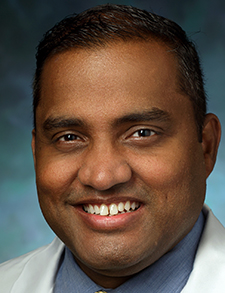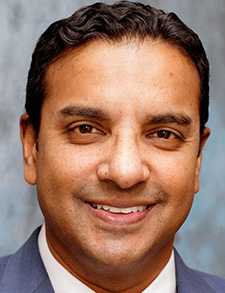As patient numbers rise, so do clerical duties, and studies are showing that many highly trained clinical staff are getting bogged down. Two hospital administrators recognized the issue and created a new nonclinical role on the medical team that focuses on clerical tasks, leaving more time for the licensed staff to spend on patient care.

Dr. Gundareddy
“With the health systems getting more complex and patient acuity rising, we can make a case for a medical assistant to medical teams to perform duties that typically don’t need a licensed provider,” said Venkat P. Gundareddy, MD, MBBS, MPH, associate director of the division of hospital medicine and assistant professor of medicine at Johns Hopkins Bayview Medical Center in Baltimore.

Dr. Sekaran
“We realized that a lot of those tasks were not fitting with working at the top of one’s license,” said Anand Sekaran, MD, division head of hospital medicine and medical director of inpatient services at Connecticut Children’s in Hartford, Conn. The Accreditation Council for Graduate Medical Education recently called for purely non-clinical tasks for residents to be limited so they can focus on actual patient care, he said.
Establishing duties
The role of a medical team assistant (MTA) can be varied based on the needs of the group, Dr. Gundareddy said. “An analogy would be that of a medical office coordinator or a medical assistant in primary care/specialty clinic settings in the outpatient world.”
This role would offset the medical team’s nonclinical workload and at the same time enhance patient safety around care transitions, he said. “Things that are not top of the license for the providers could be diverted to the assistants so the providers can focus on medical care. For example, communications with the primary care offices/specialty offices to plan a safe transition often takes time and effort.” Other tasks could include obtaining records, obtaining medication history, filling out forms for patients and facilities, obtaining prior authorizations, doing assessments such as cognitive screening, screening for safety, following up on imaging/ consult requests, and arranging family meetings.
The MTA at Connecticut Children’s has several significant roles, Dr. Sekaran said. One is to optimize team-rounds functioning. Each morning, the medical team, the appropriate nurse, the MTA, and the family gather at the bedside to discuss the plan of care. The MTA pages the patient’s nurse ahead of time to alert them that the team is approaching.
The MTA is then responsible for tracking metrics during the rounds, such as the percent of time the nurse is present, the percent of time spent on read-back of orders, and time spent teaching.
The MTA is also responsible for purely clerical, but crucially important, tasks. First, the MTA schedules follow-up appointments. About two-thirds of the hospital’s services now involve complex care, Dr. Sekaran said, resulting in patients needing multiple subspecialty appointments to be arranged before discharge. Handing already-scheduled appointments to the family has been shown in the literature to increase the compliance of keeping the appointment, as opposed to saying, “Here’s the phone number to call a doctor to get your follow-up,” he said.
The MTA also works to resolve discharge barriers, which have worsened during the pandemic. For example, if the patient needs formula or a medication that is difficult to find at a pharmacy, the MTA can call different pharmacies to find what is needed so the patient can go home in a timelier way.
The MTA position ensures patients have available home nursing care, too, Dr. Sekaran said. Staffing shortages, particularly in the home nursing component, have caused difficulty since the pandemic. “We take care of such complicated kids at Connecticut Children’s that many of them require ongoing home nursing care just for daily maintenance.”
Dr. Gundareddy said his medical center had the opportunity to pilot and develop a robust care-transitions coordinator program to support its hospitalists and house staff teams. “This was born out of necessity,” he said. “Not being able to function at the top of their license was driving down the morale of hospitalists in our group.”
They hired the first medical office coordinator more than four years ago through initial funding from the quality improvement program. Since that time, the role matured into its current form as a care-transitions coordinator. “Initial years were focused on streamlining workflows for medical documents/information flow, helping with prior authorizations, filling of forms, barrier-busting for procedures/imaging, and obtaining outside records,” Dr. Gundareddy said.
“Over the years this evolved into a safety net around transitions as we realized this is where more effort was being spent by providers,” he said. “Early identification of primary care teams, medication history gathering, effective communication between inpatient and outpatient teams, prior authorizations, lining up discharge needs, aiding in consenting and disseminating information for patients around specific things like COVID-19 vaccinations, and receiving communications from discharged patients all helped us improve our transitions of care while decreasing burden of nonclinical work on providers.”
MTAs are essential at Connecticut Children’s since pediatric hospitals, in general, have been swamped post-pandemic with mental health and non-COVID-19 respiratory issues, Dr. Sekaran said. “By having them on rounds, when things are busier, they just help with overall efficiency and flow as we manage increasingly high patient volumes.”
Creating the position
Drs. Sekaran and Gundareddy also advised on how to advocate for creating this position. The accreditation piece was a primary reason Dr. Sekaran was able to get its MTA position funded. “We framed it in the context of, ‘this is essential to maintaining adequate accreditation of our training programs’,” he said. “Secondly, we made the case successfully that it would optimize team functioning, and third, we are so busy that we needed help in patient flow and facilitating earlier discharges and optimizing the beds that we do have.”
Connecticut Children’s hired three MTAs, but the pandemic put the position on hold in 2019. Connecticut Children’s now has one MTA and is in the process of adding the other two back. “We have three main pediatric floors,” Dr. Sekaran said. “We’ve learned you need one per unit, so each unit is 28 beds. Our goal is to get back to where we were, which is one MTA medical team assistant per 28-bed unit.”
“Success in creating such a program is directly related to the institutional value it brings,” Dr. Gundareddy said. “First, we need to understand hospitalists’ workload and how much of it is not at the top of their license. Based on this needs assessment, we can build a medical assistant program to support the provider teams.”
The value of the program can be shown at various levels, he explained. At the individual level, the value translates to less burnout and more satisfaction in work. At the group/division level, the value translates to decreased turnover, better clinician engagement, and improved standardization of work delegated to the assistants. At the institution level, this role can be aligned to deliver some of the key institutional goals, such as decreased readmissions, increased communication with outpatient providers, early signing of documents, and better compliance with standards of care around transitions, Dr. Gundareddy said. “Overall, if we can show that the value far exceeds the cost of the program, institutions would be willing to support it.”
Sue Coons is a medical writer in Chapel Hill, N.C. She also has worked in the hospital patient-access area for 10 years.